The Long March rockets are a family of expendable launch system rockets operated by the China Aerospace Science and Technology Corporation. The rockets are named after the Chinese Red Army's 1934–35 Long March military retreat during the Chinese Civil War.
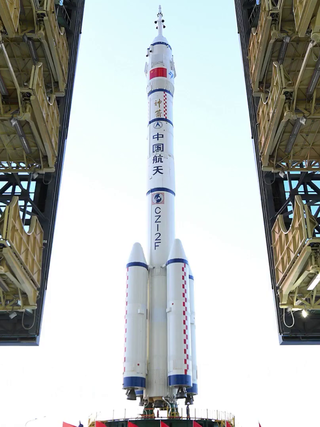
The Long March 2F, also known as the CZ-2F, LM-2F and Shenjian, is a Chinese orbital carrier rocket, part of the Long March 2 rocket family. Designed to launch crewed Shenzhou spacecraft, the Long March 2F is a human-rated two-stage version of the Long March 2E rocket, which in turn was based on the Long March 2C launch vehicle. It is launched from complex SLS at the Jiuquan Satellite Launch Center. The Long March 2F made its maiden flight on 19 November 1999, with the Shenzhou 1 spacecraft. After the flight of Shenzhou 3, CPC General Secretary and President Jiang Zemin named the rocket "Shenjian", meaning "Divine Arrow".

Jiuquan Satellite Launch Center is a Chinese space vehicle launch facility (spaceport) located between the Ejin, Alxa, Inner Mongolia and Hangtian Town, Jinta County, Jiuquan, Gansu Province. It is part of the Dongfeng Aerospace City. Because 95% of JSLC located in Jinta County, Jiuquan, the launch center is named after Jiuquan. The launch center straddles both sides of the Ruo Shui river.
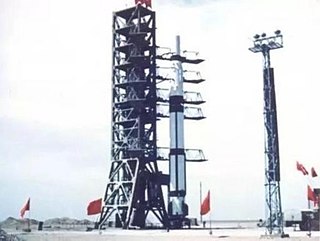
The space program of the People's Republic of China is about the activities in outer space conducted and directed by the People's Republic of China. The roots of the Chinese space program trace back to the 1950s, when, with the help of the newly allied Soviet Union, China began development of its first ballistic missile and rocket programs in response to the perceived American threats. Driven by the successes of Soviet Sputnik 1 and American Explorer 1 satellite launches in 1957 and 1958 respectively, China would launch its first satellite, Dong Fang Hong 1 in April 1970 aboard a Long March 1 rocket, making it the fifth nation to place a satellite in orbit.

The Long March 3, also known as the Changzheng 3, CZ-3 and LM-3, was a Chinese orbital carrier rocket design. They were all launched from Launch Area 3 at the Xichang Satellite Launch Center. It was a three-stage rocket, and was mostly used to place DFH-2-class communications satellites into geosynchronous transfer orbits. It was complemented and later replaced by the more powerful Long March 3A, which has an improved third stage.

The Long March 3A, also known as the Chang Zheng 3A, CZ-3A and LM-3A, is a Chinese orbital carrier rocket design. It is a 3-stage rocket, and is usually used to place communications satellites and Beidou navigation satellites into geosynchronous transfer orbits.

The Taiyuan Satellite Launch Center (TSLC) also known as Base 25 (Chinese: 二十五基地), is a People's Republic of China space and defense launch facility (spaceport). It is situated in Kelan County, Xinzhou, Shanxi Province and is the second of four launch sites having been founded in March 1966 and coming into full operation in 1968.
The Long March 1 (长征一号), also known as the Changzheng-1 (CZ-1), was the first member of China's Long March rocket family. Like the U.S.'s and the Soviet Union's first rockets, it was based on a class of ballistic missiles, namely the DF-4 class.
Long March 2 rocket family or Chang Zheng 2 rocket family as in Chinese pinyin is an expendable launch system operated by the People's Republic of China. The rockets use the abbreviations LM-2 family for export, and CZ-2 family within China, as "Chang Zheng" means "Long March" in Chinese pinyin. They are part of the larger Long March rocket family. Development and design falls mostly under the auspices of the China Academy of Launch Vehicle Technology (CALT).

Long March 5, or Changzheng 5 (CZ-5), and also by its nickname "Pang-Wu", is a Chinese heavy-lift launch vehicle developed by the China Academy of Launch Vehicle Technology (CALT). It is the first Chinese launch vehicle designed to use exclusively non-hypergolic liquid propellants. It is the fifth iteration of the Long March rocket family.

The Long March 2C (LM-2C), also known as the Chang Zheng 2C (CZ-2C), is a Chinese orbital launch vehicle, part of the Long March 2 rocket family. Developed and manufactured by the China Academy of Launch Vehicle Technology (CALT), the Long March 2C made its first launch on 9 September 1982. It is a two-stage launch vehicle with storable propellants, consisting of Nitrogen Tetroxide and Unsymmetrical Dimethylhydrazine. The launch vehicle was derived from the DF-5 ICBM.

The Wenchang Space Launch Site is a rocket launch site located in Wenchang on the island of Hainan, in China.
ChinaSat is the brand name of communications satellites operated by China Satellite Communications.
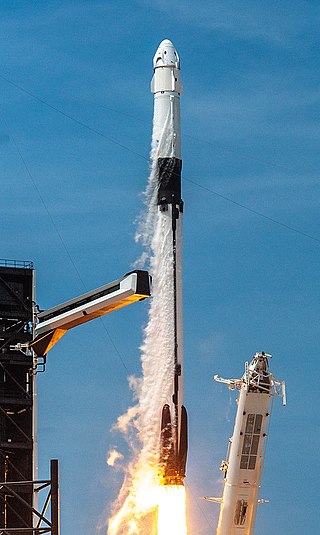
This article lists all active and upcoming orbital launch systems. For retired launch vehicles, see Comparison of retired orbital launch systems.
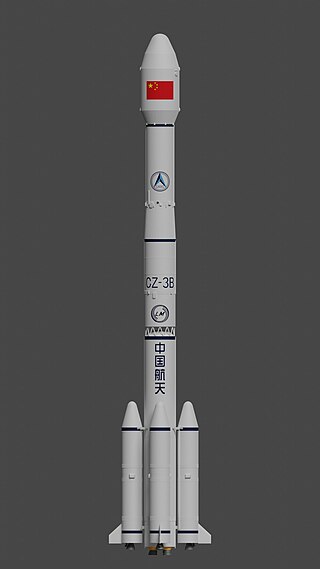
The Long March 3B, also known as the CZ-3B and LM-3B, is a Chinese orbital launch vehicle. Introduced in 1996, it is launched from Launch Area 2 and 3 at the Xichang Satellite Launch Center in Sichuan. A three-stage rocket with four strap-on liquid rocket boosters, it is the heaviest variant of the Long March 3 rocket family, and is mainly used to place communications satellites and navigation satellites into geosynchronous orbits.
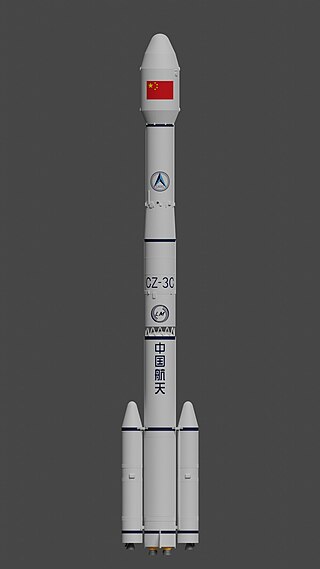
The Long March 3C, also known as the Changzheng 3C, CZ-3C and LM-3C, is a Chinese orbital launch vehicle. It is launched from Launch Complex 2 and 3 at the Xichang Satellite Launch Center (XSLC). A three-stage rocket with two strapon liquid rocket boosters, it is a member of the Long March 3 rocket family, and was derived from the Long March 3B. It was designed to fill a gap in payload capacities between the Long March 3A and 3B.

The Long March 4A, also known as the Changzheng 4A, CZ-4A and LM-4A, sometimes misidentified as the Long March 4 due to the lack of any such designated rocket, was a Chinese orbital carrier rocket. It was launched from Launch Area 7 at the Taiyuan Satellite Launch Center. It was a three-stage rocket, used for two launches in 1988 and 1990. On its maiden flight, on 6 September 1988, it placed the FY-1A weather satellite into orbit. On its second, and final, flight it launched another weather satellite, FY-1B.

The Long March 2E, also known as the Chang Zheng 2E, CZ-2E and LM-2E, was a Chinese orbital carrier rocket from the Long March 2 family. The Long March 2E was a three-stage carrier rocket that was designed to launch commercial communications satellites into geosynchronous transfer orbit. Launches took place from launch complex 2 at the Xichang Satellite Launch Center.
China plans to launch eleven Huanjing satellites for disaster and environmental monitoring. The satellites will be capable of visible, infrared, multi-spectral and synthetic-aperture radar imaging.
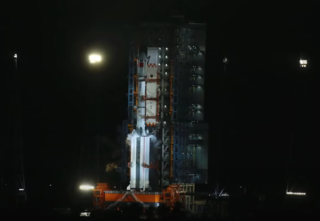
Shijian is a series of satellites built and operated by the People's Republic of China. Some Shijian-series satellites have drawn significant concerns from the United States government and space observers who cite unannounced launches, undisclosed sub-satellites deployed in orbit, unusual orbital maneuvers, and demonstrated rendezvous proximity operations (RPO) including the close inspection and towing of other satellites.
















